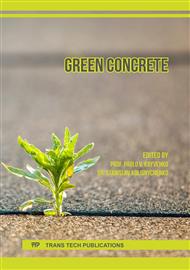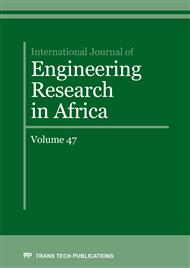[1]
A. K Tripathy, S. Mahalik, C.K Sarangi, B.C Tripathy, K. Sanjay, & I.N Bhattacharya, A pyro-hydrometallurgical process for the recovery of alumina from waste aluminum dross. Minerals Engineering, 137 (2019) 181-186.
DOI: 10.1016/j.mineng.2019.04.009
Google Scholar
[2]
M. Mahinroosta, & A. Allahverdi, A promising green process for synthesis of high purity activated-alumina nanopowder from secondary aluminum dross. Journal of cleaner production, 179 (2018) 93-102.
DOI: 10.1016/j.jclepro.2018.01.079
Google Scholar
[3]
Q Yang, Q Li, G. Zhang, Q Shi, & H Feng, Investigation of leaching kinetics of aluminum extraction from secondary aluminum dross with use of hydrochloric acid. Hydrometallurgy, 187 (2019) 158-167.
DOI: 10.1016/j.hydromet.2019.05.017
Google Scholar
[4]
A. Meshram, & K.K Singh, Recovery of valuable products from hazardous aluminum dross: A review. Resources, Conservation and Recycling, 130 (2018), 95-108.
DOI: 10.1016/j.resconrec.2017.11.026
Google Scholar
[5]
P.E Tsakiridis, P. Oustadakis, & S. Agatzini-Leonardou, Aluminium recovery during black dross hydrothermal treatment. Journal of Environmental Chemical Engineering, 1(2013) 23-32.
DOI: 10.1016/j.jece.2013.03.004
Google Scholar
[6]
T. Oresanya, C. Ben-Enukora, O. Omojola, O. Oyero, & L.O Amodu, Health communication and awareness of aluminium-waste disposal effects among Ogun state housing corporation residents. Proceedings of SOCIOINT, 4th International Conference on Education, Social Sciences and Humanities, Dubai: UAE, July 10–12, (2017).
DOI: 10.18844/prosoc.v4i10.3076
Google Scholar
[7]
R. Galindo, I. Padilla, R. Sánchez-Hernández, J.I Robla, G. Monrós, & A. López-Delgado, Production of added-value materials from a hazardous waste in the aluminium tertiary industry: Synergistic effect between hydrotalcites and glasses. Journal of Environmental Chemical Engineering, 3 (2015) 2552-2559.
DOI: 10.1016/j.jece.2015.09.012
Google Scholar
[8]
Y. Liu, B. S Leong, Z.T Hu, & E.H Yang, Autoclaved aerated concrete incorporating waste aluminum dust as foaming agent. Construction and Building Materials, 148 (2017) 140–147.
DOI: 10.1016/j.conbuildmat.2017.05.047
Google Scholar
[9]
A. Meshram, A. Jain, D. Gautam, & K.K Singh, Synthesis and characterization of tamarugite from aluminium dross: part I. Journal of Environmental Management, 232 (2019) 978-984.
DOI: 10.1016/j.jenvman.2018.12.019
Google Scholar
[10]
C. Dai, & D. Apelian, Fabrication and characterization of aluminum dross-containing mortar composites: upcycling of a waste product. Journal of Sustainable Metallurgy, 3 (2017) 230-238.
DOI: 10.1007/s40831-016-0071-7
Google Scholar
[11]
A. M. Neville, Neville's Insight and Issues. Thomas Telford books, London, (2012).
Google Scholar
[12]
E.M.M Ewais, N.M Khalil, M.S Amin, Y.M.Z Ahmed, & M.A Barakat, Utilization of aluminum sludge and aluminum slag (dross) for the manufacture of calcium aluminate cement. Ceramics International, 35 (2009), 3381-3388.
DOI: 10.1016/j.ceramint.2009.06.008
Google Scholar
[13]
D. Bajare, A. Korjakins, J. Kazjonovs, & I. Rozenstrauha, Pore structure of lightweight clay aggregate incorporate with non-metallic products coming from aluminium scrap recycling industry. Journal of the European Ceramic Society, 32 (2012) 141-148.
DOI: 10.1016/j.jeurceramsoc.2011.07.039
Google Scholar
[14]
I. Perná, & T. Hanzlíček, The solidification of aluminum production waste in geopolymer matrix. Journal of cleaner production, 84 (2014) 657-662.
DOI: 10.1016/j.jclepro.2014.04.043
Google Scholar
[15]
Z. Li, Advanced concrete technology. John Wiley & Sons (2011).
Google Scholar
[16]
M.C Shinzato, & R. Hypolito, Solid waste from aluminum recycling process: characterization and reuse of its economically valuable constituents. Waste management, 25 (2005) 37-46.
DOI: 10.1016/j.wasman.2004.08.005
Google Scholar
[17]
A.U. Elinwa, & E. Mbadike, The use of aluminum waste for concrete production. Journal of Asian Architecture and Building Engineering, 10 (2011) 217-220.
DOI: 10.3130/jaabe.10.217
Google Scholar
[18]
B. Inseemeesak, & A. Rodchanarowan, The Influence of Aluminium Dross on Cement Paste's Porosity. In Advanced Materials Research 747 (2013) 445-448.
DOI: 10.4028/www.scientific.net/amr.747.445
Google Scholar
[19]
N. Ozerkan, O. Maki, M. Anayeh, S.M Tangen, & A. Abdullah, The effect of aluminium dross on mechanical and corrosion properties of concrete, 3 (2014) 9912-9922.
Google Scholar
[20]
S.O Adeosun, O.I Sekunowo, O.O Taiwo, W.A Ayoola, & A. Machado, Physical and mechanical properties of aluminum dross. Adv. Mater., 3 (2014), 6-10.
Google Scholar
[21]
P.E Tsakiridis, P. Oustadakis, & S. Agatzini-Leonardou, Black dross leached residue: An alternative raw material for portland cement clinker. Waste and Biomass Valorization, 5 (2014) 973-983.
DOI: 10.1007/s12649-014-9313-8
Google Scholar
[22]
M.S Reddy & D. Neeraja, Mechanical and durability aspects of concrete incorporating secondary aluminium slag. Resource-Efficient Technologies, 2 (2016) 225–232.
DOI: 10.1016/j.reffit.2016.10.012
Google Scholar
[23]
G. Mailar, S. Raghavendra, B.M Sreedhara, D.S Manu, P. Hiremath, & K. Jayakesh, Investigation of concrete produced using recycled aluminium dross for hot weather concreting conditions. Resource-Efficient Technologies, 2 (2016), 68-80.
DOI: 10.1016/j.reffit.2016.06.006
Google Scholar
[24]
S. Javali, A.R Chandrashekar, S.R Naganna, D.S Manu, P. Hiremath, H.G Preethi, & N.V Kumar, Eco-concrete for sustainability: Utilizing aluminum dross and iron slag as partial replacement materials. Clean Technologies and Environmental Policy, 19 (2017) 2291–2304.
DOI: 10.1007/s10098-017-1419-9
Google Scholar
[25]
A.A Busari, I.I Akinwumi, P.O Awoyera, O.M Olofinnade, T.I Tenebe, & J.C Nwanchukwu, Stabilization Effect of Aluminum Dross on Tropical Lateritic Soil. In International Journal of Engineering Research in Africa 39 (2018) 86-96.
DOI: 10.4028/www.scientific.net/jera.39.86
Google Scholar
[26]
M. López-Alonso, M.J Martinez-Echevarria, L. Garach, A. Galán, J. Ordoñez & F. Agrela, Feasible use of recycled alumina combined with recycled aggregates in road construction. Construction and Building Materials, 195 (2019) 249-257.
DOI: 10.1016/j.conbuildmat.2018.11.084
Google Scholar
[27]
R.T Loto & A. Busari, Influence of White Aluminum Dross on the Corrosion Resistance of Reinforcement Carbon Steel in Simulated Concrete Pore Solution. Journal of Bio-and Tribo-Corrosion, 5(2019), 19.
DOI: 10.1007/s40735-018-0211-7
Google Scholar
[28]
D.O Nduka, O. Joshua, A.M Ajao, B.F. Ogunbayo & K.E Ogundipe, Influence of secondary aluminum dross (SAD) on compressive strength and water absorption capacity properties of sandcrete block. Cogent Engineering, (2019): 1608687.
DOI: 10.1080/23311916.2019.1608687
Google Scholar
[29]
UNI EN ISO 10545‐3. Determination of Water Absorption, Apparent Porosity, Apparent Relative Density and Bulk Density (2000).
DOI: 10.3403/30321734
Google Scholar
[30]
Nigeria Industrial Standard NIS 441:1 Composition, specifications and conformity criteria for common cements. Lagos: (2007), Standard Organization of Nigeria.
Google Scholar
[31]
Code, B. (2006). Federal Republic of Nigeria: National Building Code.
Google Scholar
[32]
EN, 197-1. Cement, Composition, Specifications and Conformity Criteria for Common Cements. London, England: (2011). British Standard Institution (BSI).
Google Scholar
[33]
Nigeria Industrial Standard NIS 441:1. Composition, specifications and conformity criteria for common cements. Lagos. (2004). Standard Organization of Nigeria.
Google Scholar
[34]
M.S Shetty, Concrete technology - theory and practice, (2004) S. Chand and Company Limited, New Delhi, India.
Google Scholar
[35]
BS EN 1008, Mixing Water for Concrete. (2002). British Standards Institution: London, UK.
Google Scholar
[36]
BS EN 12350-2, Testing fresh concrete-Part 2: Slump test. (2009). European Committee for Standardization.
Google Scholar
[37]
BS EN 12390-3, Testing hardened concrete. Compressive strength of test specimens. (2009). European Committee for Standardization.
Google Scholar
[38]
BS EN 12390-5, Testing Hardened Concrete. Flexural Strength of Test Specimens. (2009). British Standard Institution, London.
Google Scholar
[39]
P.K Mehta & J.M Monteiro, Concrete microstructure properties and materials (4th ed.), McGraw-Hill Education, (2014), United States.
Google Scholar
[40]
IS: 4031 (3), Methods of physical tests for hydraulic cement, part 3: determination of soundness, Bureau of Indian Standards, (1988).
Google Scholar



